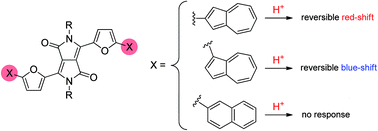Modulating structure and properties in organic chromophores: influence of azulene as a building block†
Abstract
The properties of isomeric azulene derivatives, substituted through the 5-membered ring, were examined using a combination of experimentation and theoretical calculations for a series of well-defined electroactive oligomers. The substitution pattern was shown to dramatically influence solid-state, electronic, and optical properties of the oligomers with acid-responsive materials only being observed when the azulenium cation could be directly stabilized by substituents on the 5-membered ring. In addition, the absorption maxima and optical band-gaps of the azulenium cations can be tuned by the substitution position of the azulene ring by the chromophore.


 Please wait while we load your content...
Please wait while we load your content...